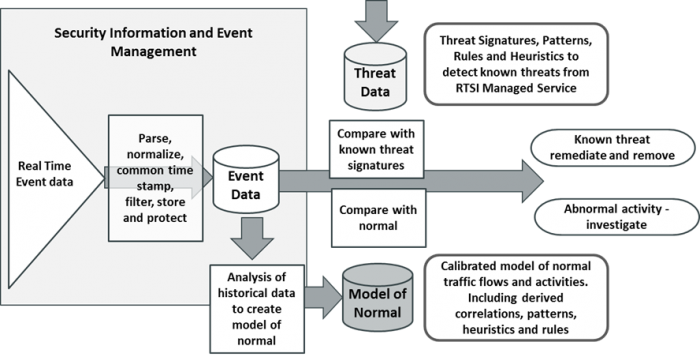Organizations depend upon the IT systems and the information that they provide to operate and grow. However, the information that they contain and the infrastructure upon which they depend is under attack. Statistics show that most data breaches are detected by agents outside of the organization rather than internal security tools. Real Time Security Intelligence (RTSI) seeks to remedy this.

Unfortunately, many organizations fail to take simple measures to protect against known weaknesses in infrastructure and applications. However, even those organizations that have taken these measures are subject to attack. The preferred technique of attacks is increasingly one of stealth; the attacker wants to gain access to the target organization’s systems and data without being noticed. The more time the attacker has for undetected access the more the opportunity to steal data or cause damage.
Traditional perimeter security devices like firewalls, IDS (Intrusion Detections Systems) and IPS (Intrusion Prevention Systems) are widely deployed. These tools are effective at removing certain kinds of weaknesses. They also generate alerts when suspicious events occur, however the volume of events is such that it is almost impossible to investigate each as they occur. Whilst these devices remain an essential part of the defence, for the agile business using cloud services, with mobile users and connecting directly to customers and partners, there is no perimeter and they are not sufficient.
SIEM (Security Information and Event Management) was promoted as a solution to these problems. However, in reality SIEM is a set of tools that can be configured and used to analyse event data after the fact and to produce reports for auditing and compliance purposes. While it is a core security technology, it has not been successful at providing actionable security intelligence in real time.
This has led to the emergence of a new technology Real Time Security Intelligence (RTSI). This is intended to detect threats in real time or in near real time to enable action to be taken before damage is done. It uses techniques taken from big data and business intelligence to reduce that massive volume of security event data collected by SIEM to a small number of actionable alarms where there is a high confidence that there is a real threat.
At the current state of the art for RTSI, Managed Services is an essential component. This is because of the rapid evolution of threats, which makes it almost impossible for a single organization to keep up to date, and the complexity of the analysis that is required to identify how to distinguish these. This up to date knowledge needs to be delivered as part of the RTSI solution.
The volume of threats to IT systems, their potential impact and the difficulty to detect them are the reasons why real time security intelligence has become important. However, RTSI technology is at an early stage and the problem of calibrating normal activity still requires considerable skill. It is important to look for a solution that can easily build on the knowledge and experience of the IT security community, vendors and service providers. End user organizations should always opt for solutions that include managed services and pre-configured analytics, not just for tools.
KuppingerCole Advisory Note: Real Time Security Intelligence - 71033 provides an in depth look at this subject.
















































